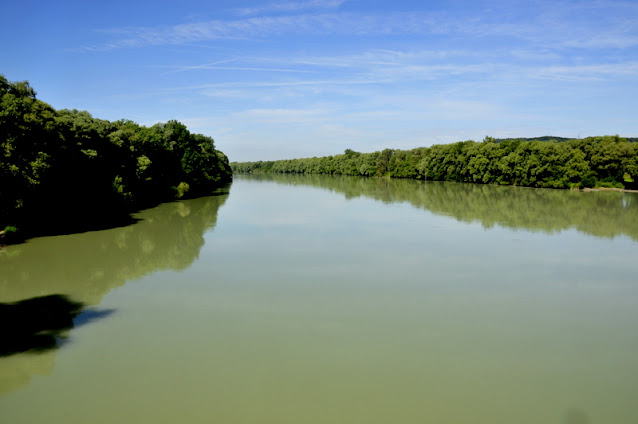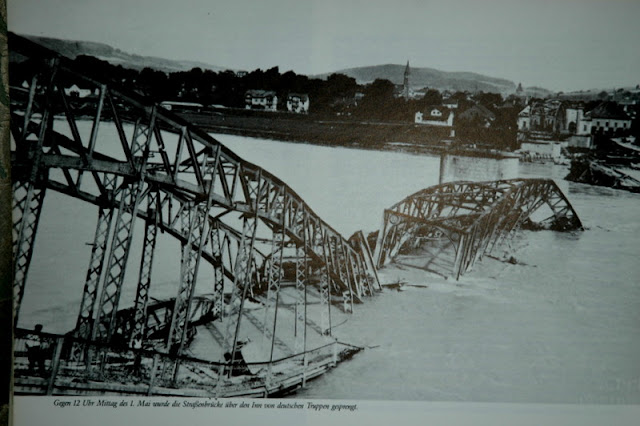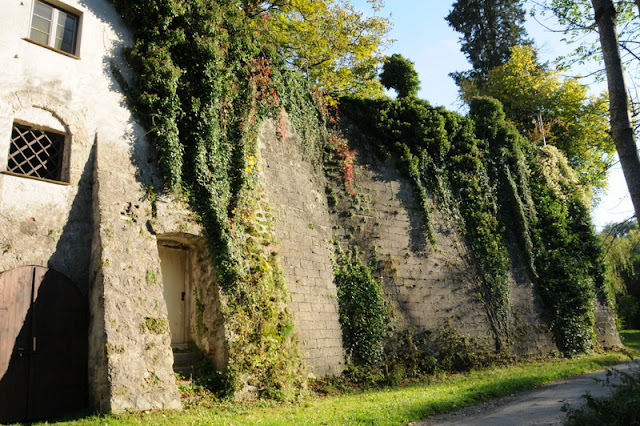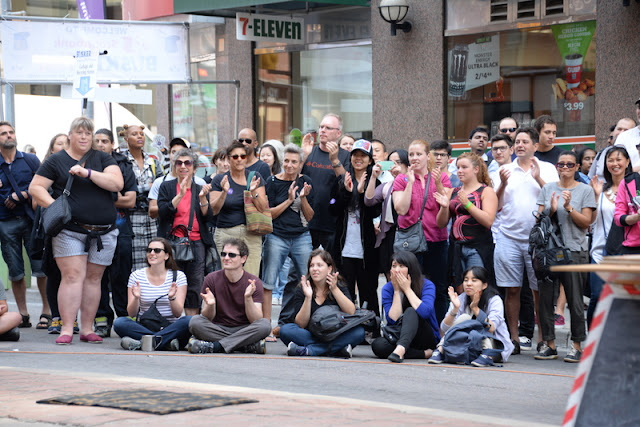Search This Blog
Friday, October 30, 2020
Wednesday, October 28, 2020
Autumn near Bleiburg
Got in my car, yesterday, and drove a few kilometers outside of Bleiburg.
While he images below do not compare with Autumn in Algonquin Park, they are, nevertheless, beautiful representatives of Autumn hereabouts.
Tuesday, October 27, 2020
Two "Kisses"
Fratelli Tutti
“Fratelli tutti”
(We are) All Brothers.
This is what Pope Franciscus called his latest Encyclical, in which he waxed enthusiastic in his condemnation of the “Free Market System.”
Corona has presented the proof, so he claimed, that “the magical theories of the Free Market Capitalism” do not function.
No, it was not Karl Marx who said that, but Pope Franciscus, who reveals himself more and more as an adherent of the Far Left in the political spectrum.
How he connects 'Covid 19' with the functioning of the Free Market System, he did not explain.
How much do you want to bet that a “Free Market” oriented firm will come up with the Inoculation against this viral disease?
He also did not explain why exactly the countries governed after his Left Wing philosophy are still the poorest of the world.
Please compare, for instance, the living standard of the poverty stricken North Korea, governed by the principles of Stalinesque Communist dictatorship, to that of its southern brother, which happens to be a Free Market Society and, (what a coincidence) counts among the richest of Asiatic countries.
Another example for Franciscus' erroneous thinking is Venezuela, which for the past over 20 years has been governed in accordance with Communist principles, and, in spite of the world's greatest oil reserves, remains one of the poorest countries of its continent.
Francis says not one word about these, or several other examples.
He does not mention the fact that it was Free Enterprise, which lifted
untold countries and untold Millions of people from abject poverty to an honorable life of relative wealth.
By innuendo the Pope likens Free Enterprise to Greed, and personal Egotism, when, in fact, this human weakness appears in all systems.
Maybe, Frances should look at his own house, where money, meant for the poor, was used to speculate in the money markets.
Why is the Vatican Bank, which he calls the “Institute for Christian Services” known the world over as one of the most corrupt financial institutions?
No, dear Franciscus, Free Enterprise is NOT the cause of universal poverty, but, in fact, it is the cause of steady improvement in the economic “Lot of Man.”
Franz Schellhorn, the leader of the Think tank “Agenda Austria”,
in his article in the 'Kleine Zeitung' of 18th October, cites the following statistics:
During the past 20 years Extreme Poverty has been reduced by 67 %
Child Mortality was reduced by 50%.
Analphabetism has been reduced by 24%.
Of this Franciscus makes no mention. Not with a single word.
Why not? Because it would not buttress his Left Wing philosophy, but utterly destroy it.
Friday, October 23, 2020
The Bridges of Braunau
The Bridges
of
Braunau
During the last days of April, just at the beginning of May, the river carried high water from the melting snowfields of the Alps and from its many tributaries.
The end of this devastating, cruel war was in sight. In fact it was only eight days ahead.
Dear Mom
In your last letter, which I got yesterday you said that you are praying for my safe return.
Please do not worry about me. We are just moving along and meet with very little, almost no resistance from the Germans.
My Company Commander said this morning that all will be over soon.
Then I will come home and if Mary-Ann hasn't found another man, but, as she said, has waited for me, I will marry her.
We'll have a humdinger of a wedding.
In any event, I am attached to an “Engineer Battalion. All we do is repair roads and, when necessary, repair damaged, or build new bridges. We get involved in fighting only rarely. There is really nothing to worry about.
I am sending to you and Dad all my best wishes and a hug for both of you.
Your son,
Lester.
The 13th Armored Division, “Black Cat” moves on, coming via the outskirts of Munich toward “Rottal am Inn”, and from there to “Alt Ötting”, small, picturesque towns along the river “Inn”.
But, “picturesque” is not really in the dictionary of those soldiers, who want nothing but the end of this war and to return home to Ohio, Nebraska, Kansas or any of the other States from which they happened to come.
“What'll you do, when this is over and we go home” Herbi asks.
Lester thinks for a moment. A small smile plays on his lips.
“Getting married. That's the first thing I'll do. Then, with my GI Grant, I'll finish College. After that”, he hesitates for a moment, “we'll see.”
“I really have no idea. Not the foggiest notion what I'll be doing. Maybe I'll stay in the Army.” Herbi says.
The truck in which the two friends ride, along with several other GIs, is one in a long chain of vehicles, driving up-river along the river Inn.
Almost bumper to bumper, 2.5 ton trucks, with light machine guns mounted, interspersed by threatening Sherman tanks, Red Cross trucks, and Jeeps, leaving the column, speeding to the top of the line up.
American Soldiers, casually, almost carelessly sit within the trucks and atop the tanks.
Two young boys walk in the opposite direction.
“Go home!” the men in the vehicles shout at them. “Go home!”
A German Army Vehicle approaches from a side road.
Machine guns stutter.
Slowly the column nears the town of Simbach.
The trucks move to the side of the road and stop.
Tanks move up.
Just in front there is a viaduct crossing the road. Heavy cement blocks on both sides and thick trees span the road. A tank barrier. Not for long.
The lead tank opens fire and the mined barrier explodes.
To the left there is a two story building. A pub on the ground floor.
There is movement behind a window. The glass shatters and a bazooka comes flying out.
It misses the lead tank by a foot and explodes against a small tobacconist's sales shed, disintegrating it to its foundation.
The first and second tank turn their turret and almost in unison two shots are fired.
The building with the pub and anybody inside is no more.
The entire column has now come to a halt.
Through the Viaduct, with the wood from the splintered tree trunks lying about, the bridgehead can be seen. The Inn river is less than two hundred meters down the road.
A halt is ordered, because it is assumed that the bridge is also mined and ready to be blown at a moment's notice.
Evening descends and, since all is quiet, field kitchens roll up.
Once a day all GIs should have a warm meal.
A Spotter Plane circles over the ancient City of Braunau and its surrounding area on the other side of the river.
Throughout the night Artillery fire rains upon the forest east of Braunau and does not cease until the early morning hours.
At about noon on the first day of May the expected explosion happens.
A column of smoke and debris rises.
Dark gray at first, then pink at the edges and then a bright red.
The warm shock wave can be felt right back to the hill range beyond Simbach.
About half an hour later, the railroad bridge disintegrates in the same manner.
A pontoon bridge will have to be laid and Colonel Smith asks for volunteers to cross the river using the remains of the destroyed bridge. It is necessary to reconnoiter the best landing place for the last pontoon in the row.
Private 1st Class, Lester Bingham and Staff Sergeant Herbert Moss readily volunteer for this difficult assignment.
It is 9.30 in the morning. Heavy fog lies upon the river. Although it is the second day of May, the temperature has dipped to only 3 degrees Celsius, and light snow is falling.
“The snow won't stay longer than a moment” Herbi says.
“But the river is freezing cold” Lester answers. “We had better not fall in!”
Carefully the two work their way across the ruins of the bridge.
Herbert in the lead and Lester following close behind.
The iron is so cold that the hands stick to it.
“Shoulda brought some gloves.” Lester says.
“Too late now; we're half way across”
On hands and feet they crawl forward.
Water splashes onto the girders, where it forms a thin layer of ice.
The hissing sound of the fast flowing river is constantly in their ears.
Cautiously they test each handhold and cautiously they make sure that the bent piece of girder is well balanced and will support their weight.
“Careful now” says Herbie. “There's the longest gap. Reach across and don't let your feet slip.”
Lester feels for the next part of the girder. There are rivets missing.
The edges of the hole, left where the rivets were torn loose, are razor sharp.
Pain shoots through Lester's left hand. Instinctively he pulls away.
He looses his grip.
His balance is gone and he hears the hissing water, as it rushes over the heavy gravel which covers the river bed.
Herbert does not even hear the cry of desperation coming from his comrade.
Lester, his heavy uniform and boots soaking up water quickly, struggles to stay afloat.
The pull of the rushing river drags him under the surface.
He fights for air, but swallows only water.
Please, he thinks, let me not drown here. I have to keep my head above water.
The fast flowing river is relentless and unforgiving.
Herbert sees his parents' faces and that of his beloved Mary-Ann.
For a moment he is ready to give up.
All turns black before his eyes.
But then an new surge of his will to survive gives him power.
Once again he fights his way to the surface.
Staff Sergeant Herbert Moss clings desperately to one of the pieces of the torn bridge. He knows that his friend has gone from the bridge.
But he cannot see his body..
He scans the surface of the river. He can see only silver wavelets and an occasional piece of flotsam.
He calls his friend's name. He hears only the steely hissing of the fast flowing river.
As fast as he can he returns to the side from which he had started.
Whenever possible he scans the debris of what was the railroad bridge.
Then he sees a fleeting movement among its twisted metal.
He knows not if his sorrow about the feared loss of his best friend has tricked him into seeing what he so desperately wanted to see.
***********************
Hi Mom, Dad and Mary-Ann.
Thanks, Mom and Dad, for praying for me. And thanks Mary-Ann for sending me the little horse shoe with the four leaf clover... I needed it.
A few days ago I almost ran out of luck. But now all is Okay again. You won't believe this. I fell into a river. Just like I used to do when I was a kid at Grandma's house in Muskogee.
When all this is over, and Uncle Sam lets me go, I think I will finish College and become... I don't know yet what. Herbie thinks he'll stay in the Army.
Can't wait till I get home again.
In the meantime think of yourselves as hugged by me.
Lester.
P.S. Hi Mary-Ann: I will write to you separately but I wanted you to know right away that I am A-Okay.
Thursday, October 22, 2020
On the First day of May, in the Year 1945
Wednesday, October 21, 2020
Some more about Braunau am Inn.
Tuesday, October 20, 2020
There was another (in)famous man.
Besides Palm, Steininger, and probably a handful of other outstanding men, there was one man, who became, beyond a doubt, the most famous, or infamous man of Braunau am Inn.
Adolf Hitler was borne in Braunau on the 20th day of April 1889.
This is surely an honor, Braunau could have done without.
It is, however, historical fact and cannot be wished away.
Adolf, directly or indirectly was responsible for some 57 Million deaths.
Should you want to know the details, you may find them in the Internet.
Monday, October 19, 2020
Hans Steininger
Another well known Citizen of Braunau was Hans Steininger.
Hans, was not only the Mayor of Braunau, but he could boast about the longest beard in this place and at this time. It was well over 5 feet long.
Unfortunately, this beard became his literal "downfall."
One day, to be precise, on the 28th September 1567, there was a fire somewhere downtown. The alarm bells were rung and Hans, being a conscientious leader of his people tried to rush to the scene of the fire.
In his haste, he had forgotten to roll up his beard and to tuck it into the little leather pouch, hanging around his neck.
Having arrived at the top of the stairs in the Town Hall, he stepped on his beard, tripped and fell and, would you believe it, Hans fell all the way to the bottom of stairs, broke his neck and was dead on the spot.
Johan Phillip Palm
Braunau am Inn, Upper Austria.
This small town of about 18,000 inhabitants has a varied, sometimes turbulent, history.
Let me just go back to the early 19th Century:
For some short time in 1805, the French Warmonger, Napoleon Bonaparte lived in Braunau, in the house, Stadtplatz 34.
The Nürnberg Book Publisher, Johan Phillip Palm, printed and marketed a booklet, dealing with Germany's occupation by Napoleon, called “Germany in its deep Humiliation”.
Since he steadfastly refused to divulge the name of the author, he was executed by firing squad, on the order of Napoleon, on the 26th August 1806, just outside the Braunau city walls.
The building in which he was incarcerated, as well as the location of his execution are kept as a place of remembrance, warning against the loss of “Freedom of the Press.”
Sunday, October 18, 2020
Braunau am Inn
Two famous people come from this town:
There is I and there is another one about whom we shall not speak.
Braunau has about 18,000 inhabitants and is a busy trade center of the so-called "Innviertel" ( a Quarter Section by the river Inn )
I grew up there from age 4 to 23 and I am hard pressed to find a better place in which to grow up.
Tuesday, October 13, 2020
Buskers in Toronto.
What, or who, is a “Busker”?
A Busker, so Wikipedia tells us, is a person who performs music or any other art of entertainment, in the street, or any other public place, for donations.
My last Busker Festival I experienced in Toronto in early September of 2017.
There were musicians, jugglers, acrobats, singers, dancers, street-painters and more.
Some, just beautiful women, beautifully dressed and beautifully made up.
There is food and drinks and laughter and just general fun!
Mostly there are children enjoying life. They sit on the road and with eyes wide open they show their astonishment and admiration at “the buskers.”
In typical, Canadian relaxed fashion, Toronto's main road, “Yonge Street” is blocked to all traffic, so that buskers may have their way.

























































